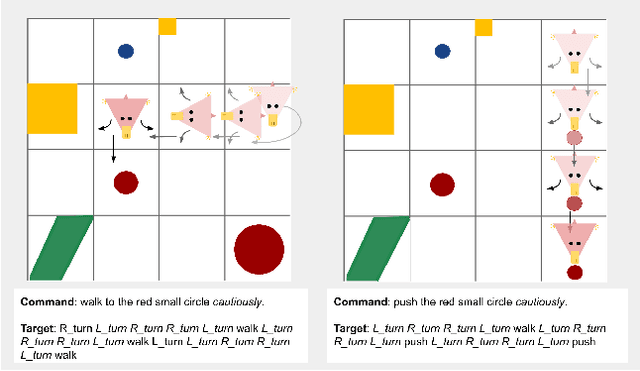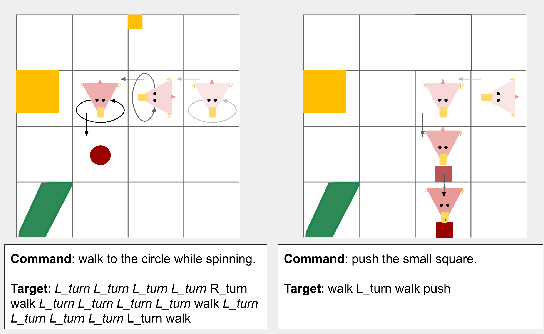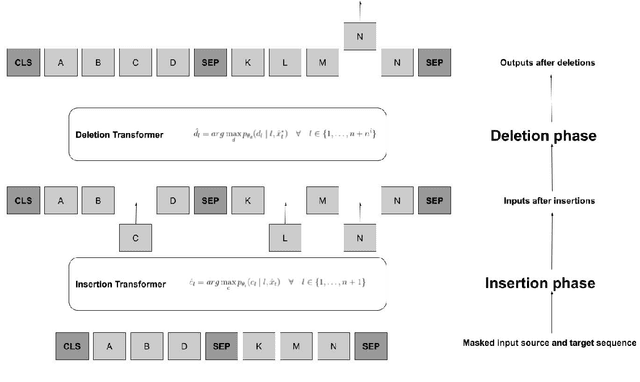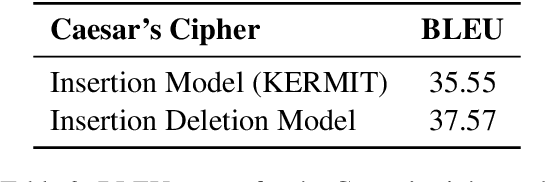Laura Ruis
Programming by Backprop: LLMs Acquire Reusable Algorithmic Abstractions During Code Training
Jun 23, 2025Abstract:Training large language models (LLMs) on source code significantly enhances their general-purpose reasoning abilities, but the mechanisms underlying this generalisation are poorly understood. In this paper, we propose Programming by Backprop (PBB) as a potential driver of this effect - teaching a model to evaluate a program for inputs by training on its source code alone, without ever seeing I/O examples. To explore this idea, we finetune LLMs on two sets of programs representing simple maths problems and algorithms: one with source code and I/O examples (w/ IO), the other with source code only (w/o IO). We find evidence that LLMs have some ability to evaluate w/o IO programs for inputs in a range of experimental settings, and make several observations. Firstly, PBB works significantly better when programs are provided as code rather than semantically equivalent language descriptions. Secondly, LLMs can produce outputs for w/o IO programs directly, by implicitly evaluating the program within the forward pass, and more reliably when stepping through the program in-context via chain-of-thought. We further show that PBB leads to more robust evaluation of programs across inputs than training on I/O pairs drawn from a distribution that mirrors naturally occurring data. Our findings suggest a mechanism for enhanced reasoning through code training: it allows LLMs to internalise reusable algorithmic abstractions. Significant scope remains for future work to enable LLMs to more effectively learn from symbolic procedures, and progress in this direction opens other avenues like model alignment by training on formal constitutional principles.
Command A: An Enterprise-Ready Large Language Model
Apr 01, 2025



Abstract:In this report we describe the development of Command A, a powerful large language model purpose-built to excel at real-world enterprise use cases. Command A is an agent-optimised and multilingual-capable model, with support for 23 languages of global business, and a novel hybrid architecture balancing efficiency with top of the range performance. It offers best-in-class Retrieval Augmented Generation (RAG) capabilities with grounding and tool use to automate sophisticated business processes. These abilities are achieved through a decentralised training approach, including self-refinement algorithms and model merging techniques. We also include results for Command R7B which shares capability and architectural similarities to Command A. Weights for both models have been released for research purposes. This technical report details our original training pipeline and presents an extensive evaluation of our models across a suite of enterprise-relevant tasks and public benchmarks, demonstrating excellent performance and efficiency.
Investigating Non-Transitivity in LLM-as-a-Judge
Feb 19, 2025Abstract:Automatic evaluation methods based on large language models (LLMs) are emerging as the standard tool for assessing the instruction-following abilities of LLM-based agents. The most common method in this paradigm, pairwise comparisons with a baseline model, critically depends on the assumption of transitive preferences. However, the validity of this assumption remains largely unexplored. In this study, we investigate the presence of non-transitivity within the AlpacaEval framework and analyze its effects on model rankings. We find that LLM judges exhibit non-transitive preferences, leading to rankings that are sensitive to the choice of the baseline model. To mitigate this issue, we show that round-robin tournaments combined with Bradley-Terry models of preference can produce more reliable rankings. Notably, our method increases both the Spearman correlation and the Kendall correlation with Chatbot Arena (95.0% -> 96.4% and 82.1% -> 86.3% respectively). To address the computational cost of round-robin tournaments, we propose Swiss-Wise Iterative Matchmaking (Swim) tournaments, using a dynamic matching strategy to capture the benefits of round-robin tournaments while maintaining computational efficiency.
Procedural Knowledge in Pretraining Drives Reasoning in Large Language Models
Nov 19, 2024



Abstract:The capabilities and limitations of Large Language Models have been sketched out in great detail in recent years, providing an intriguing yet conflicting picture. On the one hand, LLMs demonstrate a general ability to solve problems. On the other hand, they show surprising reasoning gaps when compared to humans, casting doubt on the robustness of their generalisation strategies. The sheer volume of data used in the design of LLMs has precluded us from applying the method traditionally used to measure generalisation: train-test set separation. To overcome this, we study what kind of generalisation strategies LLMs employ when performing reasoning tasks by investigating the pretraining data they rely on. For two models of different sizes (7B and 35B) and 2.5B of their pretraining tokens, we identify what documents influence the model outputs for three simple mathematical reasoning tasks and contrast this to the data that are influential for answering factual questions. We find that, while the models rely on mostly distinct sets of data for each factual question, a document often has a similar influence across different reasoning questions within the same task, indicating the presence of procedural knowledge. We further find that the answers to factual questions often show up in the most influential data. However, for reasoning questions the answers usually do not show up as highly influential, nor do the answers to the intermediate reasoning steps. When we characterise the top ranked documents for the reasoning questions qualitatively, we confirm that the influential documents often contain procedural knowledge, like demonstrating how to obtain a solution using formulae or code. Our findings indicate that the approach to reasoning the models use is unlike retrieval, and more like a generalisable strategy that synthesises procedural knowledge from documents doing a similar form of reasoning.
Towards Reliable Evaluation of Behavior Steering Interventions in LLMs
Oct 22, 2024Abstract:Representation engineering methods have recently shown promise for enabling efficient steering of model behavior. However, evaluation pipelines for these methods have primarily relied on subjective demonstrations, instead of quantitative, objective metrics. We aim to take a step towards addressing this issue by advocating for four properties missing from current evaluations: (i) contexts sufficiently similar to downstream tasks should be used for assessing intervention quality; (ii) model likelihoods should be accounted for; (iii) evaluations should allow for standardized comparisons across different target behaviors; and (iv) baseline comparisons should be offered. We introduce an evaluation pipeline grounded in these criteria, offering both a quantitative and visual analysis of how effectively a given method works. We use this pipeline to evaluate two representation engineering methods on how effectively they can steer behaviors such as truthfulness and corrigibility, finding that some interventions are less effective than previously reported.
Debating with More Persuasive LLMs Leads to More Truthful Answers
Feb 15, 2024Abstract:Common methods for aligning large language models (LLMs) with desired behaviour heavily rely on human-labelled data. However, as models grow increasingly sophisticated, they will surpass human expertise, and the role of human evaluation will evolve into non-experts overseeing experts. In anticipation of this, we ask: can weaker models assess the correctness of stronger models? We investigate this question in an analogous setting, where stronger models (experts) possess the necessary information to answer questions and weaker models (non-experts) lack this information. The method we evaluate is \textit{debate}, where two LLM experts each argue for a different answer, and a non-expert selects the answer. We find that debate consistently helps both non-expert models and humans answer questions, achieving 76\% and 88\% accuracy respectively (naive baselines obtain 48\% and 60\%). Furthermore, optimising expert debaters for persuasiveness in an unsupervised manner improves non-expert ability to identify the truth in debates. Our results provide encouraging empirical evidence for the viability of aligning models with debate in the absence of ground truth.
Large language models are not zero-shot communicators
Oct 26, 2022Abstract:Despite widespread use of LLMs as conversational agents, evaluations of performance fail to capture a crucial aspect of communication: interpreting language in context. Humans interpret language using beliefs and prior knowledge about the world. For example, we intuitively understand the response "I wore gloves" to the question "Did you leave fingerprints?" as meaning "No". To investigate whether LLMs have the ability to make this type of inference, known as an implicature, we design a simple task and evaluate widely used state-of-the-art models. We find that, despite only evaluating on utterances that require a binary inference (yes or no), most perform close to random. Models adapted to be "aligned with human intent" perform much better, but still show a significant gap with human performance. We present our findings as the starting point for further research into evaluating how LLMs interpret language in context and to drive the development of more pragmatic and useful models of human discourse.
Improving Systematic Generalization Through Modularity and Augmentation
Feb 22, 2022


Abstract:Systematic generalization is the ability to combine known parts into novel meaning; an important aspect of efficient human learning, but a weakness of neural network learning. In this work, we investigate how two well-known modeling principles -- modularity and data augmentation -- affect systematic generalization of neural networks in grounded language learning. We analyze how large the vocabulary needs to be to achieve systematic generalization and how similar the augmented data needs to be to the problem at hand. Our findings show that even in the controlled setting of a synthetic benchmark, achieving systematic generalization remains very difficult. After training on an augmented dataset with almost forty times more adverbs than the original problem, a non-modular baseline is not able to systematically generalize to a novel combination of a known verb and adverb. When separating the task into cognitive processes like perception and navigation, a modular neural network is able to utilize the augmented data and generalize more systematically, achieving 70% and 40% exact match increase over state-of-the-art on two gSCAN tests that have not previously been improved. We hope that this work gives insight into the drivers of systematic generalization, and what we still need to improve for neural networks to learn more like humans do.
A Benchmark for Systematic Generalization in Grounded Language Understanding
Mar 11, 2020



Abstract:Human language users easily interpret expressions that describe unfamiliar situations composed from familiar parts ("greet the pink brontosaurus by the ferris wheel"). Modern neural networks, by contrast, struggle to interpret compositions unseen in training. In this paper, we introduce a new benchmark, gSCAN, for evaluating compositional generalization in models of situated language understanding. We take inspiration from standard models of meaning composition in formal linguistics. Going beyond an earlier related benchmark that focused on syntactic aspects of generalization, gSCAN defines a language grounded in the states of a grid world. This allows us to build novel generalization tasks that probe the acquisition of linguistically motivated rules. For example, agents must understand how adjectives such as 'small' are interpreted relative to the current world state or how adverbs such as 'cautiously' combine with new verbs. We test a strong multi-modal baseline model and a state-of-the-art compositional method finding that, in most cases, they fail dramatically when generalization requires systematic compositional rules.
Insertion-Deletion Transformer
Jan 15, 2020



Abstract:We propose the Insertion-Deletion Transformer, a novel transformer-based neural architecture and training method for sequence generation. The model consists of two phases that are executed iteratively, 1) an insertion phase and 2) a deletion phase. The insertion phase parameterizes a distribution of insertions on the current output hypothesis, while the deletion phase parameterizes a distribution of deletions over the current output hypothesis. The training method is a principled and simple algorithm, where the deletion model obtains its signal directly on-policy from the insertion model output. We demonstrate the effectiveness of our Insertion-Deletion Transformer on synthetic translation tasks, obtaining significant BLEU score improvement over an insertion-only model.
 Add to Chrome
Add to Chrome Add to Firefox
Add to Firefox Add to Edge
Add to Edge